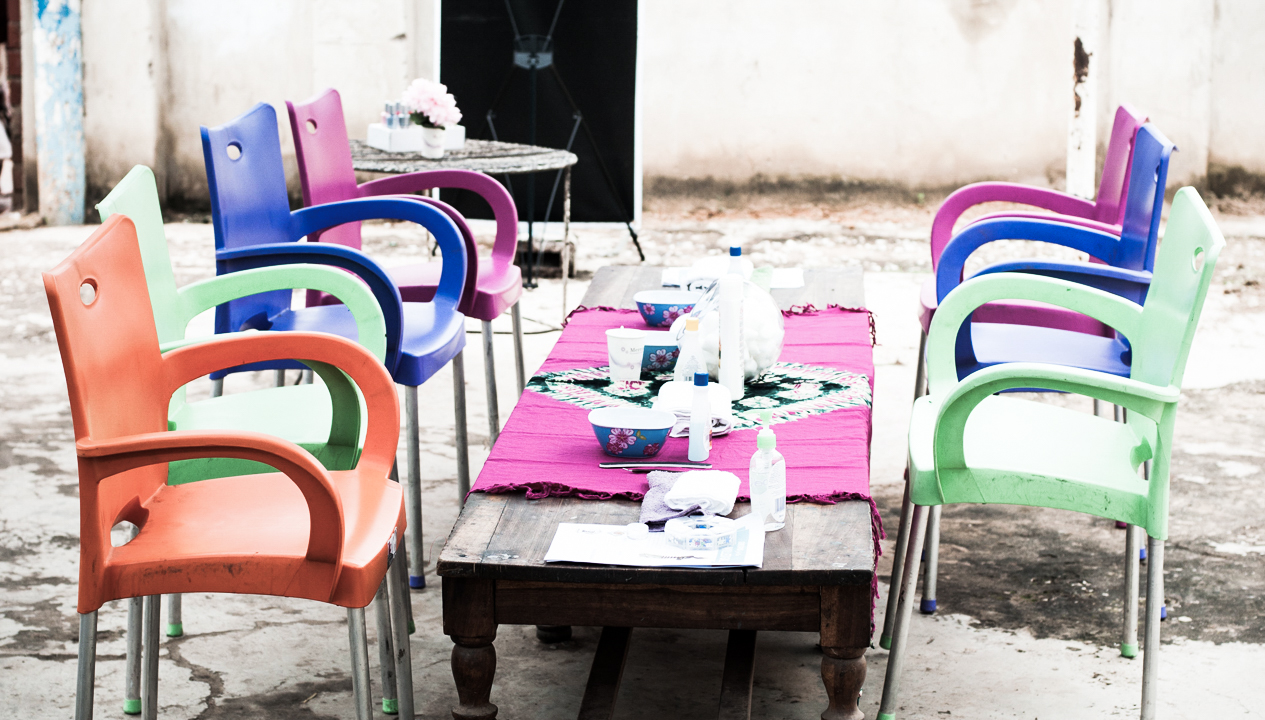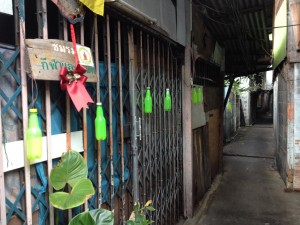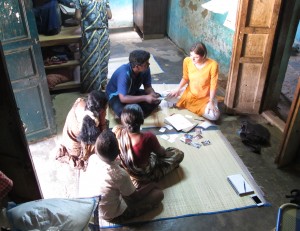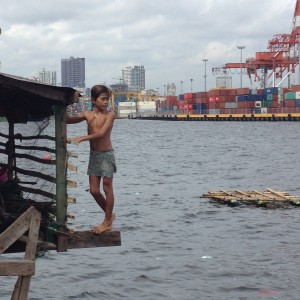Mariana Prieto (Product Design + DM Concentration ’12) is a teacher, strategist, and product designer. She uses empathy, creativity, and practicality as a base to explore innovative solutions that can positively impact the quality of life for a community. As the co-founder of Blue Barrel Concepts, Mariana leads research and ideation on concepts aimed at improving the quality of life for people without access to running water.
Currently Mariana is finishing up her IDEO.org Fellowship and in the future will continue working on human centered design projects and workshops based out of New York City.
10 LESSONS FROM THE FIELD AS AN IDEO.ORG FELLOW
“How was the IDEO.org Fellowship?” many people ask. Although extraordinary, intriguing, surprising, challenging, and rewarding all are words that immediately come to mind, I don’t want to oversimplify my answer and leave it at that. I am still digesting the wonderful learnings and lessons that I have gathered in the last year. For now, let me start by focusing on my time doing research and prototyping out in the field. Over the course of the past year, I’ve spent a cumulative five and a half months traveling and visiting the communities where we work. This is where the magic happens. This is where our work intersects with the people we are designing for and why so many of us choose to follow the path of social design.
During this year I have taken on five design challenges ranging from agriculture development in India, family planning in Zambia, financial stability in the Philippines, and the health and life of informal workers in South Africa, Kenya, Thailand, and the Philippines. Chapter 1 is about the 10 lessons I have learned from fieldwork as an IDEO.org Fellow (who knows, maybe I decide to give writing ‘Chapter 2: Lessons from the studio’ a try, so I’m calling this one Chapter 1).
Here are 10 lessons from the field:
1. Sometimes, the dumber the better. Many of the interesting and surprising things I learned in far and remote places came from asking seemingly ridiculous questions. We often forget that, as designers, we’re sent to the field to uncover insights that may be obvious to a local but surprising to a newcomer. But for this we have to be inquisitive, observant, and sometimes ask the dumb questions.
During one project when we were in Bangkok researching the lives of informal workers, there was a particular day when I didn’t have any recruits and found myself wandering in a small slum outside the city looking for someone to talk to. I walked through an alley where I came across a group of young men gathered around a small table playing checkers. After striking up a conversation, I noticed that most men were drinking Pepsi and only one had a Mountain Dew. I wanted to maintain friendly conversation and asked the first thing that came to mind. “How’s your drink? Do you like Mountain Dew?” As soon as I said it I realized how dumb I probably sounded, but it was too late to take it back. “No”, he said “But the alley where I live is dark.”
When he saw my bewildered look, he proceeded to point at the row of Mountain Dew bottles lining the dark alley way and others hanging off the back of pick-up trucks. The neon tint in the bottles was used as a source of inexpensive and accessible reflective material.
Hopefully you won’t only ask dumb questions, but when you are curious, don’t be afraid to ask.
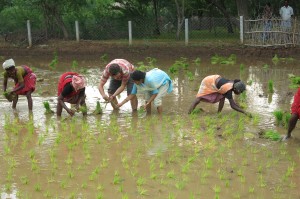
Rice paddy in southern India. If you look closely you can see Martin Schnitzer learning the craft of rice planting from local farmers. Courtesy of IDEO.org
2. Jumping in the deep end. When we do design research it is critical to feed our intuition and get a sense of how the community works—what they love, who they are, and how community members interact with one another. But we can’t always learn these things from just asking questions point blank. This intangible intuition is what we have left when we return to the studio millions of miles away and start designing.
So how do we do cultural immersion? It’s just one basic principle: go out there and do what others are doing. Through my last year doing research, I have planted rice fields, skinned cow heads, peeled vegetables whose names I can’t pronounce, recycled cardboard and plastic, gone second hand clothes shopping with Zambian teens, gotten a weave (a small strand anyway), made candles, gone clubbing with rappers in Lusaka, milked cows and even been homeless for a day.
One particularly fruitful experience was the day I worked as a waste picker in South Africa. Our team wanted to learn about networks in the informal economy, and we still had a lot of questions. I embedded myself in a team of waste pickers by helping them collect, separate, and bundle trash. During that morning, just by being there and being (what I hope was) helpful, I realized the street vendors and the waste pickers from this one area had a beautiful symbiotic relationship. The vendors would supply them with boxes and the recyclers would store their merchandise in the warehouse where they slept overnight. They also stored the street performers’ instruments and props so they wouldn’t have to haul them home every day.
Even through hours of interviews with both of these men, this network never came up. I may have never uncovered this unique exchange that happens each morning and evening by interviews alone, because what seems trivial and mundane to some, can feel exceptional to others.

Little girl at a ‘sari sari’ store at the market in Tacloban, Philippines. Photo courtesy of IDEO.org.
3. Go to people when they don’t come to you. Stuff happens in the field. Sometimes recruitments fall through, or your recruiter can’t work on a holiday that everyone (except you, of course!) knows to plan around. Well, these are the opportunities to go out and meet the most amazing people that you wouldn’t meet otherwise. Our most common strategy to meet wonderful people (if project appropriate) is to go to the local fish or vegetable market in the morning. We get up early and approach friendly vendors. We ask them a few simple questions about their produce, and then with a smile and a small explanation, we ask if we can join them for a while in their stall for a short chat. If things go well, we ask if they can join us for a longer interview or introduce us to their stall neighbor or cousin who is “just a few stalls down”. It’s a wonderful way to get to know people and the inner workings of a market. Always remember to buy some produce at the end–I have finished many workdays with pounds of lemons, garlic, and potatoes.
On a project for informal workers this was a great way to get to know the market community. But for every topic we may be exploring, there is a casual way to meet great people and hear their stories.
My favorite serendipitous encounter came from talking to the parking attendant at our hotel in Durban, South Africa. He ended up being a Congolese refugee who invited us to join him at his church that Sunday. We not only met his family, but we were welcomed into the entire Congolese refugee community in a way that brought tears of joy to our whole team. They formally added us their local family with open arms and open hearts.
In the end, things will fall through. Things will go wrong. Don’t panic, but rather make the best of it by finding where your research participants gather and go greet them with a friendly smile.
4. Accept what is offered to you, except a chair. The principle here is simple. Be polite, honest, and as humble as you can. The goal is to connect as deeply and genuinely as possible with people in their own home. I have found two rules of thumb that can help. The first one is to accept whatever drink is offered to you. It is better to accept a cup of water with a smile, wet your lips, and “forget to drink it” than to refuse the offer all together.
The second rule of thumb is to refuse the chair. Though everyone will try to offer you the best seat in the house, don’t take it. It is better to sit on the floor with everyone or accept a chair only if everyone else is on chairs as well. Avoid sitting above people at any time. Following this simple rule will help shift the power dynamic and avoid making the conversation feel like an interrogation.
5. The Packing List. My field research learning guide wouldn’t be complete without a mention to the dreaded, ever-changing packing list. Here are a few lessons I learned (mostly the hard way) about what to bring.
1. Keep a home toothbrush AND a travel toothbrush or you’ll end up with no toothbrush at all.
2. Bring travel converters (for layover countries too) in your carry on so you can plug in at the airport, charge in the plane in some cases or even be the hero at an airport for someone else who forgot theirs.
3. Add a scented candle and an extra sheet so you’re prepared for any kind of hotel room, anywhere.
4. And a printer. A printer? Yes. Traveling with a printer for a prototyping trip will save you hundreds of dollars, a great deal of time, and the stress of not only finding a printing place, but one that is open anytime you need it. And many times in rural towns, it will end up being the only option you’ll have to print those prototyping flyers and stickers you need.
5. Pack a Polaroid Camera. For that moment when you are saying good bye to a sweet family that just invited you to their farm for tea, ask if they will take a picture with you. It’s a warm way to say thank you and good-bye and always makes people smile.
6. “To go fast, travel alone. To go far, travel together” – Leymah Gbowee. One of my favorite parts of a project is sitting down for an official team kick off. During this time, each team member shares their personal and professional fears and hopes with each other (captured with drawings on Post-its of course). We also share what skills we bring to the table, what we want to learn from this project, and most importantly, how we best respond when stressed or hungry. This exercise is informative, but more importantly, it opens up the possibility of being upfront and honest to your team members about these issues when times become difficult.
The strain of teamwork in the field is similar to the strain of any team, however it’s magnified by being far from home. We’re working and living together 24/7 for several weeks at a time and are far from the things that typically bring us comfort. Being upfront about our weaknesses and how we respond best to feedback makes the experience in the field a more open and honest one and nourishes healthy team relationships. A great deal of my learning experience at IDEO.org has come directly from my teammates who are passionate, talented, and wonderful people. I will miss them dearly once I leave.
7. It is OK to be not be OK. It took me a while to realize that I had the option to say to my team “I need some time alone.” Once I did, it changed the way I performed in the field because I could take the time I needed to be introverted, to rest and come back fully energized in the morning. Fieldwork is both physically and emotionally draining, and I needed to be able to tell the difference between the times I needed space and the times I needed to have a philosophical conversation about poverty, balance, inspiration, or our role in society. Being up front and honest about feeling vulnerable made me a stronger team member.
8. The poorest places we explore are the richest places in the world. Tatai Luis, a retired fisherman in the Philippines said to me, “strength comes from struggle and making ends meet. We are proud survivors as that is what gives us the courage to keep going on. Inspiration on the other hand, comes from a coffee cup I get every morning by the docks with ‘the guys’ at 5:00am watching the sunrise. They help me believe in what could come next.” Just like Tatai Luis, I find my inspiration from people. But what he didn’t realize is that I find inspiration from meeting people like him . People who make me believe that change is possible and that continuing to work together to make those dreams “of what could come next” a reality, or at least a possibility for more proud survivors like him, is worth the fight.
Wherever we travel we find beauty. Beauty in a smile, beauty in a small child that shares his only waffle for the day with three other kids, beauty in the strong sense of community that living in extreme conditions can foster. “When you are very poor and have a good community it’s like you were never poor at all,” said a wonderful blind woman named Visitación. “If a guest comes to visit and I don’t have any food to offer, I can always count on a neighbor to bring some and we then have an even better and warmer group gathering.”
Through my work I will continue to seek inspiration and beauty in the people I meet, and I hope to be half as lucky as they are in so many beautiful ways. We become better people and create better solutions by recognizing and supporting the richness that already exists within the communities we visit.
9. Question Everything. Why must there always be 10 things on a list? I’ll leave it at nine and will take this bullet point to thank you for listening to a few thoughts on this extraordinary, intriguing, surprising, challenging, and rewarding journey that was the IDEO.org Fellowship. Here’s to whatever comes next and the daily pursuit of absolute happiness.
